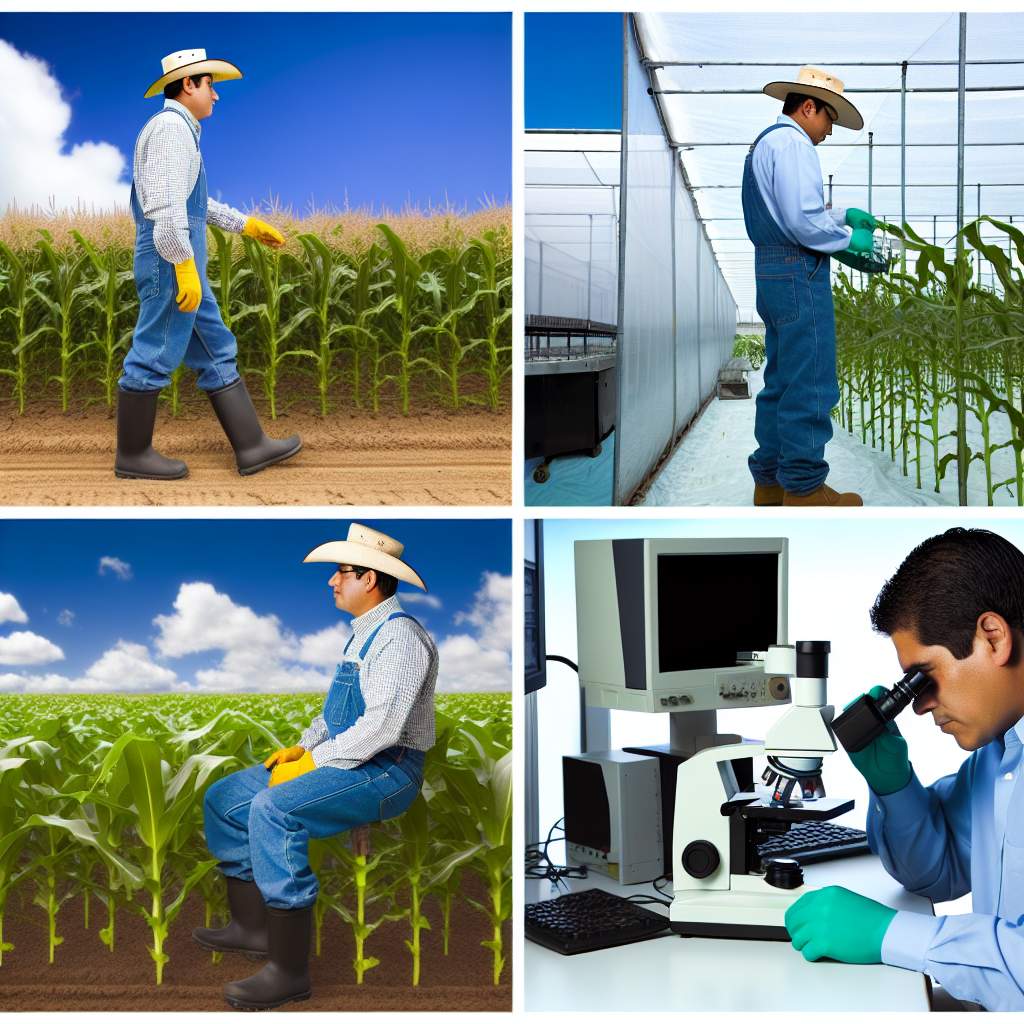Introduction:
Agricultural technicians play a critical role in ensuring the efficiency and productivity of farming operations.
They are responsible for assisting agricultural scientists in conducting experiments, collecting data, and implementing best practices.
The work environment of agricultural technicians significantly impacts their job satisfaction and overall productivity.
A conducive work environment can enhance their performance, job engagement, and overall well-being.
This leads to better outcomes for the agricultural sector.
Physical work environments:
Description of typical settings where agricultural technicians work:
Agricultural technicians can be found working in a variety of settings such as farms, research facilities, or government agencies.
These environments often involve hands-on work with crops, livestock, and equipment.
Discussion of outdoor work environments:
Agricultural technicians spend a significant amount of time working outdoors.
This can involve tasks such as planting and harvesting crops, tending to livestock, and maintaining equipment.
Outdoor work environments provide technicians with the opportunity to work directly with nature and observe agricultural processes firsthand.
Exposure to varying weather conditions:
One of the key challenges of working in outdoor agricultural environments is exposure to varying weather conditions.
Technicians may need to work in extreme heat, cold, wind, or rain.
This can make the work physically demanding and require technicians to adapt to changing weather conditions quickly.
Proper protective gear and clothing are essential to ensure the safety and comfort of agricultural technicians in these environments.
Equipment and Tools Used in Work Environments
As an agricultural technician, you will be using a variety of equipment and tools to perform your job effectively.
These tools are essential for completing tasks efficiently and accurately.
Explanation of the Machinery, Technology, and Instruments
- Tractors: Tractors are one of the most common pieces of equipment used by agricultural technicians. They are versatile machines that can be used for various tasks such as plowing, planting, and harvesting.
- Harvesters: Harvesters are specialized machines used to gather crops from the fields. They come in different sizes and types, depending on the crop being harvested.
- Soil Testing Kits: Soil testing kits are used to analyze the nutrient content of the soil. This information is crucial for determining the type and amount of fertilizer required for optimal crop growth.
- GPS Technology: GPS technology is widely used in agriculture to map fields, track equipment, and monitor crop health. It helps agricultural technicians optimize their operations and increase productivity.
- Weather Monitoring Tools: Weather monitoring tools such as rain gauges and temperature sensors are essential for predicting weather patterns and making informed decisions about planting and harvesting crops.
- Irrigation Systems: Irrigation systems are used to deliver water to crops efficiently. They help conserve water and ensure that crops receive the right amount of moisture for healthy growth.
Importance of Maintaining Equipment
It is crucial for agricultural technicians to maintain their equipment properly to ensure safety and efficiency in work environments.
Transform Your Career Today
Unlock a personalized career strategy that drives real results. Get tailored advice and a roadmap designed just for you.
Start NowRegular maintenance helps prevent breakdowns, accidents, and costly repairs.
- Safety: Properly maintained equipment reduces the risk of accidents and injuries in the workplace. Regular inspections and repairs help identify potential hazards before they cause harm.
- Efficiency: Well-maintained equipment operates at its maximum efficiency, allowing agricultural technicians to complete tasks quickly and accurately. This leads to higher productivity and better results.
- Cost-Effectiveness: Regular maintenance can extend the lifespan of equipment and reduce the need for costly replacements. It is more economical to invest in maintenance than to deal with unexpected breakdowns.
- Compliance: Many regulatory agencies require agricultural companies to maintain their equipment to specific standards. Compliance with these regulations is essential to avoid fines and legal issues.
Agricultural technicians rely on a variety of equipment and tools to perform their job effectively.
Maintaining this equipment is vital for ensuring safety, efficiency, and compliance in work environments.
Delve into the Subject: Agricultural Economists’ Role in Agricultural Policy Reform
Safety in Agricultural Environments
When it comes to working in agricultural environments, safety is paramount.
Various safety protocols and regulations are in place to ensure the well-being of agricultural technicians.
These measures primarily focus on preventing accidents and injuries.
Safety Protocols
One of the crucial safety measures implemented in agricultural work is the use of personal protective equipment (PPE).
This equipment includes gloves, goggles, respirators, and safety boots.
These items protect technicians from potential hazards present in their working environment.
Regular safety training and education sessions are conducted for technicians.
These sessions ensure awareness of the risks related to their work and strategies to mitigate them.
Proper handling of equipment, chemicals, and machinery is a crucial part of this training.
Emergency response plans are also critical in agricultural safety measures.
Agricultural technicians receive training on appropriate actions during emergencies.
Examples include responding to chemical spills, fires, or injuries.
Regular maintenance and inspection of equipment and machinery are integral to safety protocols.
Ensuring everything is in good working order helps prevent accidents caused by equipment failure.
OSHA Regulations
The Occupational Safety and Health Administration (OSHA) sets regulations to ensure worker safety in various industries.
Agriculture is one of the sectors covered by these regulations.
Transform Your Career Today
Unlock a personalized career strategy that drives real results. Get tailored advice and a roadmap designed just for you.
Start NowOSHA regulations address specific hazards and risks associated with agricultural work.
Employers are mandated to provide a safe working environment for agricultural technicians.
This includes conducting regular safety inspections and providing necessary PPE.
Technicians must also be adequately trained to follow these safety protocols.
OSHA regulations require employers to keep records of work-related injuries and illnesses.
This helps create a strong culture of safety in agricultural work environments.
Overall, safety protocols and OSHA regulations play a crucial role in ensuring agricultural technicians work safely.
By following these guidelines, employers can prevent accidents and injuries.
This allows technicians to focus on their work with peace of mind.
Explore Further: The Impact of Climate Change on Food Science
Collaborative Work Environments:
Collaboration is key in agricultural technician work environments.
Technicians often work alongside farmers, scientists, and other professionals to achieve common goals and objectives.
-
Description of Teamwork:
Agricultural technicians work in teams to conduct research, collect data, and implement strategies to improve agricultural practices.
Collaboration involves sharing ideas, expertise, and resources.
-
Importance of Effective Communication:
Communication is vital in ensuring that all team members are on the same page.
Clear and open communication helps prevent misunderstandings and promotes efficiency in carrying out tasks.
-
Coordination in Achieving Common Goals:
Coordination among agricultural technicians, farmers, and scientists is necessary to align efforts towards achieving shared objectives.
Each member plays a unique role that contributes to the overall success of the project.
-
Benefits of Collaboration:
Working together allows for the pooling of diverse skills and knowledge, leading to innovative solutions to agricultural challenges.
Collaborative work environments promote creativity, teamwork, and mutual support.
-
Challenges in Collaboration:
Despite the benefits, challenges such as conflicting priorities, differing opinions, and communication barriers can arise.
Resolving conflicts and fostering a culture of respect and understanding are essential in overcoming these obstacles.
Teamwork Dynamics:
Teamwork among agricultural technicians involves a dynamic interplay of roles and responsibilities. Each team member contributes unique skills and expertise to the collaborative effort.
-
Division of Tasks:
Agricultural technicians divide tasks based on individual strengths and interests.
Some may focus on data collection, while others may specialize in analyzing results or implementing solutions.
-
Team Leadership:
Effective teamwork requires strong leadership to guide and coordinate the group’s activities.
A designated team leader or project manager helps set goals, delegate tasks, and facilitate communication among team members.
-
Supportive Environment:
Creating a supportive work environment fosters trust and camaraderie among team members.
Recognizing and appreciating each other’s contributions promotes motivation and collaboration within the team.
-
Problem-Solving:
When challenges arise, teamwork allows for brainstorming and problem-solving as a collective effort.
By leveraging diverse perspectives and skills, the team can find innovative solutions to overcome obstacles.
-
Celebrating Achievements:
Recognizing and celebrating milestones and achievements boosts morale and strengthens team cohesion.
By acknowledging individual and collective successes, team members feel valued and motivated to continue working towards shared goals.
Effective Communication Strategies:
Communication plays a crucial role in ensuring smooth collaboration among agricultural technicians, farmers, and scientists. Implementing effective communication strategies is essential for success.
-
Regular Team Meetings:
Scheduled team meetings provide a platform for discussing progress, sharing updates, and addressing any issues or concerns.
Clear agendas and action items help keep the team focused and accountable.
-
Utilizing Communication Tools:
Technology tools such as emails, messaging apps, and project management software facilitate communication and collaboration among team members.
These tools streamline information sharing and enhance coordination.
-
Active Listening:
Practicing active listening fosters better understanding and empathy among team members.
By listening attentively to diverse viewpoints, agricultural technicians can cultivate a culture of respect and open dialogue.
-
Feedback Mechanisms:
Establishing feedback mechanisms allows team members to provide input, suggestions, and constructive criticism.
Feedback loops promote continuous improvement and help address issues proactively.
-
Cultural Sensitivity:
Cultural diversity among team members requires sensitivity and inclusivity in communication.
Recognizing and respecting cultural differences fosters a positive and harmonious work environment.
Learn More: How to Become an Agricultural Laborer: Step-by-Step Guide

Environmental impact and sustainability:
As agricultural technicians play a crucial role in modern farming practices, their contribution to sustainable agriculture and environmental conservation is significant.
- Utilization of organic farming methods:
- Integration of precision agriculture:
- Promotion of agroforestry practices:
Agricultural technicians often promote and implement organic farming techniques that eliminate the use of synthetic chemicals, reducing the ecological impact on the environment.
Through the use of advanced technologies, such as GPS-guided equipment, agricultural technicians help farmers optimize resource use, minimize waste, and reduce environmental harm.
Agricultural technicians advocate for the integration of trees and crops in farming systems, which enhances biodiversity, improves soil health, and mitigates climate change by sequestering carbon.
Discussion of initiatives to minimize the ecological footprint of agricultural work environments:
To further reduce the environmental impact of agricultural work environments, various initiatives can be implemented by agricultural technicians.
Transform Your Career Today
Unlock a personalized career strategy that drives real results. Get tailored advice and a roadmap designed just for you.
Start Now- Adoption of integrated pest management (IPM) techniques:
- Implementation of conservation tillage practices:
- Efficient water management strategies:
Agricultural technicians can promote the use of IPM strategies that focus on biological control methods, crop rotation, and targeted pesticide application to minimize environmental contamination.
By encouraging conservation tillage methods like no-till or reduced tillage, agricultural technicians help preserve soil structure, reduce erosion, and enhance water retention, leading to improved environmental sustainability.
Agricultural technicians can assist farmers in implementing water-saving irrigation techniques, such as drip irrigation or soil moisture sensors, to conserve water resources and minimize water pollution in agricultural settings.
Gain More Insights: Promoting Agricultural Careers to Students
Career Advancement Opportunities:
Overview of Potential Growth Prospects for Agricultural Technicians in Various Work Environments:
As an agricultural technician, there is a wide range of opportunities for career advancement in various work environments.
Whether you work on a farm, in a research lab, or for a government agency, there are plenty of avenues to explore to further your career.
Explanation of Further Education, Certifications, and Training Programs for Career Development and Specialization:
One of the best ways to advance your career as an agricultural technician is to pursue further education, certifications, and training programs.
These can help you specialize in a specific area of agriculture, increase your knowledge and skills, and open up new opportunities for advancement.
- Pursue Higher Education:
Taking courses or obtaining a degree in agricultural science or a related field can provide you with a deeper understanding of the industry and the latest advancements in technology. - Obtain Certifications:
There are various certifications available for agricultural technicians, such as Certified Crop Adviser (CCA), Certified Professional Agronomist (CPAg), or Certified Agricultural Consultant (CAC). - Attend Training Programs:
Many organizations offer training programs for agricultural technicians to enhance their knowledge and skills in specific areas, such as soil health, pest management, or crop production. - Specialize in a Niche Area:
By focusing on a niche area of agriculture, such as precision farming, organic agriculture, or sustainable agriculture, you can differentiate yourself from other technicians and become an expert in a specialized field.
There are numerous career advancement opportunities available for agricultural technicians in various work environments.
By pursuing further education, certifications, and training programs, you can enhance your skills, knowledge, and expertise, and position yourself for a successful and fulfilling career in the agriculture industry.
Agricultural Technician Work Environments
When it comes to Agricultural Technician work environments, a variety of factors contribute to shaping the experiences and outcomes of technicians in the field.
Field Work
Agricultural Technicians often spend a significant amount of time in the field, working directly with crops and livestock.
Laboratory Settings
In addition to field work, technicians may also work in laboratory settings, conducting tests and experiments to improve agricultural practices.
Technology Integration
Modern agricultural work environments are increasingly integrating technology, requiring technicians to stay updated on the latest advancements.
Environmental Conditions
Technicians must be prepared to work in a variety of environmental conditions, from extreme heat to heavy rain, to ensure the success of agricultural operations.
Team Collaboration
Collaboration with other agricultural professionals, such as farmers, agronomists, and researchers, is key to ensuring the success of projects and initiatives.
Work-Life Balance
Striking a balance between work responsibilities and personal life is important for the overall well-being of agricultural technicians.
Continuous Learning
Given the dynamic nature of the industry, technicians must engage in continuous learning to adapt to changes and evolving technologies in agriculture.
Work environments play a crucial role in shaping the experiences and outcomes of agricultural technicians, highlighting the need for adaptability and continuous learning in this field.
The dynamic nature of agricultural work environments underscores the evolving role of technicians in the industry, emphasizing the importance of staying abreast of technological advancements and collaborating with other professionals for success.
Transform Your Career Today
Unlock a personalized career strategy that drives real results. Get tailored advice and a roadmap designed just for you.
Start NowAdditional Resources
Agricultural Commodity Technician (GS-1981) | Agricultural …
19-4012.00 – Agricultural Technicians
[E-Books for Sale]
The Big Book of 500 High-Paying Jobs in America: Unlock Your Earning Potential
$19.99 • 500 High-Paying Jobs • 330 pages
Explore 500 high-paying jobs in America and learn how to boost your career, earn more, and achieve success!
See All 500 High-Paying Jobs of this E-Book
1001 Professions Without a Degree: High-Paying American Jobs You Can Start Now
$19.99 • 1001 Professions Without a Degree • 174 pages
Discover 1001 high-paying jobs without a degree! Unlock career tips, skills, and success strategies for just $19.99!




